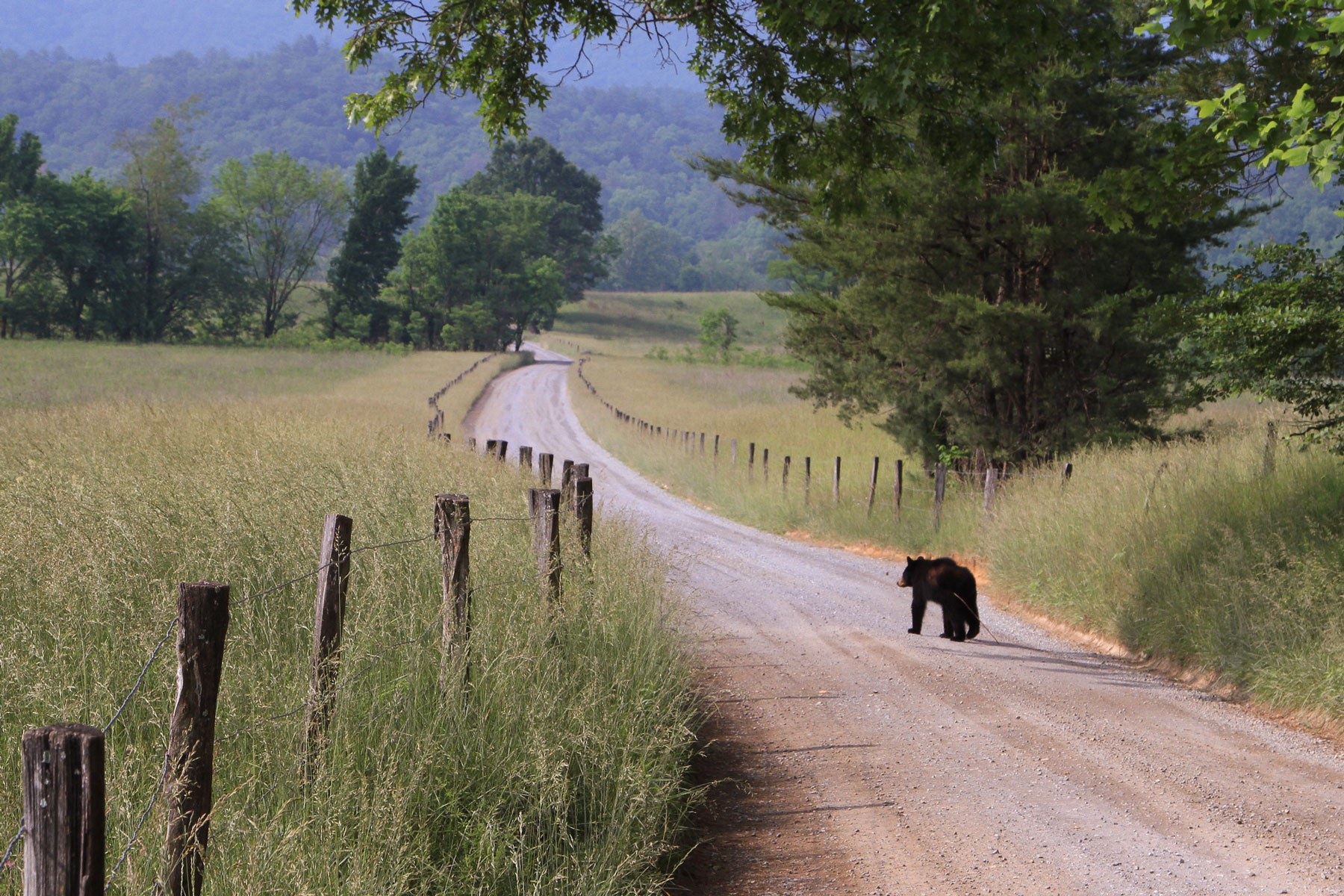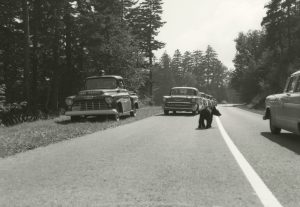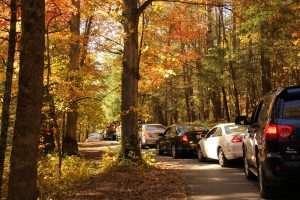
No one who visits the Smokies, particularly during the summer, should be surprised to encounter that long-time park phenomenon known as the bear jam.

Someone spots a black bear along a park road. Brakes bring the car to a screeching halt. Sometimes the bear spotter pulls to the side of the road (if possible). Sometimes the driver will simply stop in the road, overly excited by the possibility of seeing a bear in the wild and not being too concerned about following traffic. It’s a bear, after all. Everything else becomes secondary.
Other cars arrive on both sides of the road. It’s a pretty good bet that an animal of some sort has been seen if drivers turn the road into a parking lot. Within a few minutes, there’s a bear jam, with traffic backing up in both directions.
I am a veteran bear jammer, having encountered such vehicular duress on numerous occasions and in numerous park locations. They are all quite similar. People leave their cars—even in the middle of the road—and run toward the crowd, anxious to get a glimpse of the bear before it returns to the relative safety of the woods. Cell phone cameras are aimed with precision. And sometimes the more reckless in the group may wander too close to the bear—a very bad idea.
Bear jams are not unusual in Cades Cove, and on that narrow, one-way loop through that magical valley, they can tie up traffic for long periods. And perhaps it’s no surprise. Seeing a black bear in the wild for the first time is a memory many will cherish for the rest of their lives.

“As many times as I have been to the cove and as many bear jams as I’ve experienced, I still get just as excited about seeing bears as visitors do,” said Valerie Polk, videographer for Great Smoky Mountains Association who created the film A Place Called Cades Cove. “Bears are so driven by their appetites that they venture near the roads for things like blackberries and herbaceous plants to eat. They dangle in cherry trees near parking areas and field edges creating an aerial spectacle for visitors. Unfortunately, there can be quite a lot of food-type garbage, scraps, wrappers, and such that attract them to areas people use too, which is something that visitors can help prevent. The opportunity to watch a black bear in its native habitat feeding on its favorite natural seasonal food—from a safe distance—is spectacular.”
The last time I encountered a bear in the cove, I was behind about 20 other cars. A park ranger was already on the scene attempting to un-jam the jam. I noticed that the bear in question—a cub—was on a large limb overhanging the road. As traffic slowly moved through the area, a guy on a motorcycle stopped directly under the bear and zeroed in on the critter with his cell phone.
This was not advisable, as the ranger quickly informed the visitor, and he moved along, probably with a very fuzzy photo of the already-fuzzy bear.
For some who work in the Smokies, bear jams have become such an inseparable part of the park experience that wildlife encounters without a roadside audience seem to stand out.

“After working at Cades Cove Visitor Center between 2016 and 2018 and experiencing many, many bear jams—some of which added a good 20 to 30 minutes onto my commute without the reward of even seeing the bear—I couldn’t help but feel the universe was somehow rewarding me for my patience during a recent trip to the Canadian Rockies,” said Emma Oxford, who now works as a graphic designer for GSMA. “Driving through Yoho National Park, which felt almost deserted in the shoulder-season month of May, I spotted something big and brown loping along the river. I asked my wife to pull the car over and quickly recognized the animal as one neither of us had seen before—a grizzly bear. Incredibly, the bear decided to wade through a shallow section of water, climb the hillside to the highway, and saunter right across the road in front of our car, which we remained inside, naturally. It was truly an encounter I will never forget.”
While some of the most remote parks may offer less-crowded roadside viewing experiences, the bear-jam phenomenon is not unique to the Smokies. On a visit to Glacier National Park a few years ago, I rounded a curve to see a line of cars pulled to the side of the road and a crowd of about 25 people watching something in the nearby brush. “A bear!” I yelled to no one in particular.
Not much gets past me in the national park environment.
After parking safely, we joined the crowd, and sure enough, they were watching a grizzly about 75 yards away, the distance maintained by a watchful park ranger. Suddenly, the grizzly stood up to its full height (an awesome sight) and surveyed the surroundings, seemingly paying little attention to the humans gasping in awe and firing off photo after photo.
After a few minutes of this excellent experience, the ranger politely suggested that we return to our cars so that traffic along that particular road could return to some level of normalcy.
For me, it reinforced the idea that, given the chance to see a large native animal in the wild, most people will seize the opportunity. For at least a while, their driving skills are in the backseat.
Mike Hembree is a veteran journalist and the author of 14 books. He has visited 26 national parks and hopes to add many more to that list.
Subscribe to get the latest posts sent to your email.
The Great Smokies Welcome Center is located on U.S. 321 in Townsend, TN, 2 miles from the west entrance to Great Smoky Mountains National Park. Visitors can get information about things to see and do in and around the national park and shop from a wide selection of books, gifts, and other Smokies merchandise. Daily, weekly, and annual parking tags for the national park are also available.